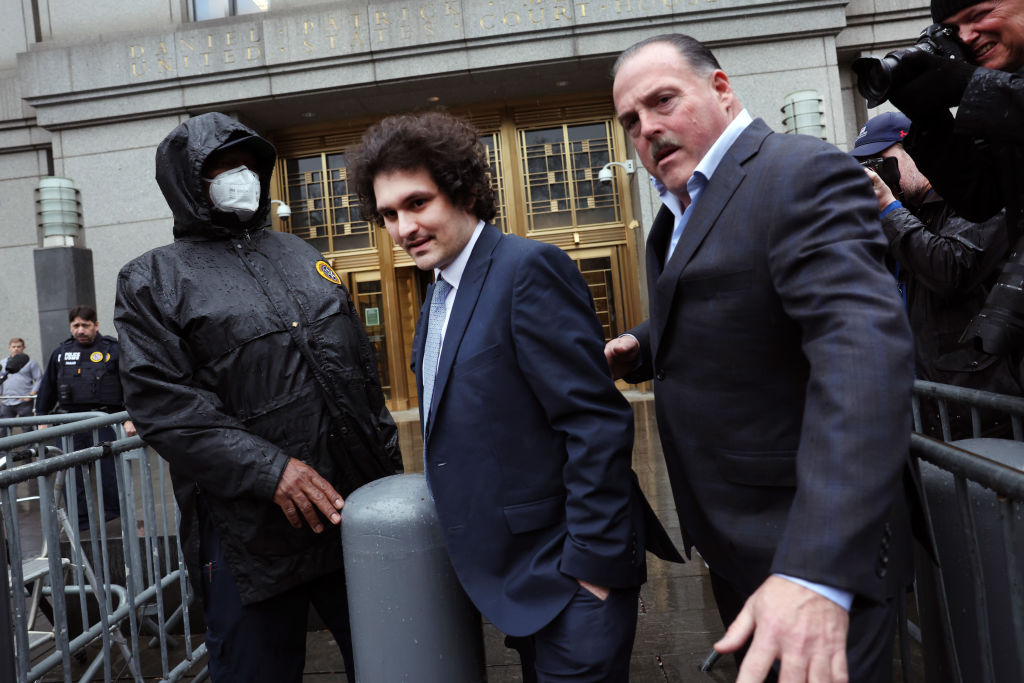The rise and continuing downfall of crypto billionaire Sam Bankman-Fried has brought a constant stream of revelations. With the first of Bankman-Fried’s two criminal trials set to take place on Oct. 2, Forkast has compiled the key details readers need to know ahead of the trial.
Who is Sam Bankman-Fried?
Sam Bankman-Fried first shot to fame in crypto circles in 2018 when he claimed his hedge fund Alameda Research secured impressive 10% daily gains on million dollar Bitcoin arbitrage trades between Japan and the U.S.
By 2019, Bankman-Fried was building FTX, a crypto exchange he said would rival the “s-–show exchanges” Alameda traded on. Within three months of its launch, FTX had up to $200 million in daily volume and conducted know-your-customer services on over 10,000 clients, per a report from The Block.
As the crypto market boomed, so did Bankman-Fried’s wealth. Forbes placed the then 29-year-old’s net worth at US$26.5 billion. It wasn’t long until he caught the attention of mainstream media outlets with his hefty political contributions — Bankman-Fried was a major donor to President Joe Biden’s 2020 campaign — and his effective altruism philosophy.
Bankman-Fried quickly became crypto’s go-to spokesperson and FTX went from strength to strength. It added some of the venture industry’s most venerable players to its cap table including Sequoia, Lightspeed, Tiger Global and BlackRock and nabbed a series of significant marketing deals. Those ranged from a Super Bowl ad spot to the naming rights for NBA team Miami Heat’s arena.
By late 2021, FTX ranked as the second leading exchange in crypto derivatives after Binance. FTX also secured a valuation of US$32 billion and counted many of the industry’s top traders and companies as customers including Galaxy Digital, QCP Capital and Amber Group.
When did it all fall apart for crypto’s boy wonder?
FTX customers were caught off guard when things at the exchange took a turn for the worse in November last year. A report from Coindesk showed Alameda’s balance sheet contained a significant proportion of illiquid assets, predominantly in FTX’s native token FTT. This triggered fears about the exchange’s financial condition, especially after competitor exchange Binance liquidated its entire FTT holdings.
“FTX is fine,” wrote Bankman-Fried on Twitter in response to Binance’s decision.
But, all was not fine. FTT’s price continued to plummet and more FTX users were requesting to withdraw.
Within 24 hours, on-chain data showed FTX could be facing a liquidity crunch when it stopped processing withdrawal requests. Bankman-Fried announced Binance would step in to acquire FTX’s non-U.S. business to help clear out the liquidity crunch. However, the deal never materialized.
Facing an US$8 billion shortfall in customer funds, Bloomberg reported that Bankman-Fried was faced with the decision to either raise more cash or file for bankruptcy. By Nov. 11, FTX filed for bankruptcy and John J. Ray III, who led Enron’s liquidation, replaced Bankman-Fried as chief executive officer to oversee bankruptcy proceedings.
“Never in my career have I seen such a complete failure of corporate controls,” said Ray in FTX’s first day pleadings.
As Ray tried to get a handle on the position of FTX and its 130-plus subsidiary companies, Bankman-Fried went on a media tour telling his side of the story. Ray accused Bankman-Fried of deliberately undermining the bankruptcy process via his appearances and tweets.
What are the charges against Bankman-Fried?
Bankman-Fried’s media tour grinded to a halt when the U.S. Securities Exchange Commission (SEC), the U.S. Commodities Futures Trading Commission (CFTC) and the U.S. Attorney’s Office filed parallel criminal and civil charges against him. He was arrested at a residence in the Bahamas on Dec. 12.
The SEC and CFTC cases are on hold until the completion of the Department of Justice’s criminal case where he is facing a total of 12 charges including:
- Two counts of wire fraud and two counts of conspiracy to commit wire fraud.
- One count to commit commodities fraud and one count of conspiracy to commit commodities fraud.
- One count to commit securities fraud and one count of conspiracy to commit securities fraud.
- One count of conspiracy to commit money laundering.
- One count of conspiracy to commit bank fraud.
- One count of conspiracy to operate an unlicensed money transmitting business.
- One count of conspiracy to violate the anti-bribery provisions of the Foreign Corrupt Practices Act.
The 31-year-old could face 150 years in prison if convicted on all counts. His case has been assigned to U.S. District Court Judge Lewis Kaplan.
When is the trial? Could Bankman-Fried strike a plea deal?
Bankman-Fried’s trial will be split into two parts with the first trial taking place on Oct. 2.
Eight charges were included in the initial indictment filed in December. The indictment was then revised to add five additional charges. A campaign finance charge made in the initial indictment was dropped by prosecutors in July.
Prosecutors requested to withdraw the five additional charges, scheduling a second trial for those in March next year. Prosecutors said in a filing Bankman-Fried won a ruling enabling him to argue that the Bahamian government should not consent to the additional charges. The issue could take a significant amount of time to resolve, necessitating the delay for the second trial.
Bankman-Fried has pleaded not guilty to all charges brought against him but he could still try to strike a plea deal at any point. Whether the U.S. government accepts it is another question. It could depend on whether he shares information that could “cut down to size a bigger fish like Binance,” said Terrence Yang, managing director at Bitcoin-focused platform Swan.
“The sensational nature of this case makes it a good opportunity for the government to make an example of SBF in a public way by refusing to make any plea deal,” said Alex More, head of litigation at Carrington, Coleman, Solman and Blumenthal.
A plea deal could still prove worthwhile, however, saving significant time and resources for the prosecution and the court, More said. And with Bankman-Fried currently serving time in jail, some have speculated it may also sober him to the reality of serving time in prison, making him more likely to strike a deal, he added.
What will Bankman-Fried’s legal defense likely be?
Speculation is already forming around Bankman-Fried’s likely legal defense. He is represented by Mark Cohen and Christian Everdell, partners at law firm Cohen & Gresser.
Bankman-Fried looks likely to partially use an “advice of counsel” strategy, according to a court filing. Under this defense he will claim he was “acting in good faith” when it came to alleged conduct such as loaning funds to executives and setting messages to auto-delete because he was following the advice of in-house lawyers as well as outside law firm Fenwick & West.
Regardless of strategy, Bankman-Fried is set to face enormous legal bills. He tried to gain access to FTX’s directors and officers insurance policy, which protects executives against legal action. But a U.S district bankruptcy court denied his request.
FTX is trying to clawback an illegal US$10 million loan made to Bankman-Fried’s father. The liquidators believe it has been used to bankroll his son’s legal defense.
Who are expected to be key witnesses?
A 70-page court filing shows prosecutors intending to draw on testimonies from Bankman-Fried’s closest advisers, expert witnesses and former FTX employees, lenders and investors.
FTX co-founders Gary Wang and Nishad Singh as well as former Alameda Research CEO Caroline Ellison have all pleaded guilty to criminal charges and are cooperating with investigators.
Former FTX executives Dan Friedberg and Ryan Salame have also reportedly spoken with prosecutors. In the court filing, the prosecution said Salame would be unavailable as a witness because he intends to invoke his Fifth Amendment right if subpoenaed. Sam Trabucco, who co-led Alameda Research with Ellison but departed before its collapse, is yet to be mentioned in the case.
“With so many of his associates accepting and negotiating for plea deals, there may be little legal incentive for Bankman-Fried to plead guilty (i.e. it will be unlikely to give him more favorable terms or sentencing),” said Mriganka Pattnaik, CEO of blockchain forensics platform Merkle Science.
Bankman-Fried has been accused of multiple forms of witness interference — from trying to establish “a constructive relationship” with one witness, to leaking the diary of former romantic partner Ellison to the press — resulting in restrictions being imposed on him.
The government has not been “soft spoken” in describing Bankman-Fried’s actions, Pattnaik said. The witness tampering only added fuel to that fire.
“When the government feels that the actions were this egregious, they are highly unlikely to offer a plea deal to the leader behind them,” he added.
Who remains on Bankman-Fried’s side?
Until recently Bankman-Fried was under house arrest at his parent’s home in California. His parents Joe Bankman and Barbara Fried, who are both professors at Stanford University, co-signed Bankman-Fried’s US$250 million bond in a bail package. The package included two additional bonds signed by Larry Kramer and Andreas Paepcke, who also work at Stanford.
Bankman-Fried has received visits from the press and “The Big Short” author Michael Lewis, who is working on a book about him.
Wait, is Bankman-Fried already in jail?
Bankman-Fried is now in jail, at Brooklyn’s Metropolitan Detention Center, after his bail was revoked Aug. 11 for witness interference on at least two occasions.
What should we expect in the month before the trial?
The defense has argued that Bankman-Fried’s conditions in jail are unsuitable for the preparation of his defense — which is document heavy and relies significantly on internet access — especially in light of seven million pages of discovery introduced by the prosecution in late August. The judge has raised the prospect of a five-month delay to trial to allow Bankman-Fried to review the new evidence, according to a Reuters report on a virtual hearing.
“Bankman-Fried may do more legal posturing to try to stall the trial,” said Merkle Science’s Pattnaik. “With this scenario, it would be possible to see more delaying tactics from him and his team, so they can bide time to prepare a stronger defense.”






